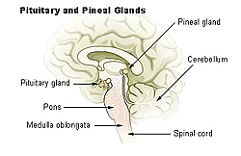The pineal gland or epiphysis synthesises and secretes melatonin, a structurally simple hormone that communicates information about environmental lighting to various parts of the body. Ultimately, melatonin has the ability to entrain biological rhythms and has important effects on reproductive function of many animals. It is the light -transducing ability of the pineal gland has led some to call the pineal the “third eye”.

ANATOMY OF THE PINEAL GLAND
The pineal gland is a small organ shaped like a pine cone (hence its name). It is located on the midline, attached to the posterior end of the roof of the third ventricle in the brain. The pineal varies in size among species; in humans it is roughly 1 cm in length, whereas in dogs it is only about 1 mm long. To observe the pineal, reflect the cerebral hemispheres laterally and look for a small greyish bump in front of the cerebellum.

Histologically, the pineal is composed of “pinealocytes” and glial cells. In older animals, the pineal often often contain calcium deposits.
How does the retina transmit information about light-dark exposure to the pineal gland? Light exposure to the retina is first relayed to the suprachiasmatic nucleus of the hypothalamus, an area of the brain well known to coordinate biological clock signals. Fibers from the hypothalamus descend to the spinal cord and ultimately project to the superior cervical ganglia, from which post-ganglionic neurons ascend back to the pineal gland. Thus, the pineal is similar to the adrenal medulla in the sense that it transduces signals from the sympathetic nervous system into a hormonal signal.
MELATONIN: SYNTHESIS, SECRETION AND RECEPTORS

The precursor to melatonin is serotonin, a neurotransmitter that itself is derived from the amino acid tryptophan. Within the pineal gland, serotonin is acetylated and then methylated to yield melatonin.
Synthesis and secretion of melatonin is dramatically affected by light exposure to the eyes. The fundamental pattern observed is that serum concentrations of melatonin are low during the daylight hours, and increase to a peak during the dark.
The effects of work fi and non Ionizing radiation also inhibit the secretion of melatonin.
Examples of the circadian rhythm in melatonin secretion in humans is depicted in the figure below. The dark gray bars represent night, and serum melatonin levels are shown for two individuals (yellow versus light blue). Note that blood levels of melatonin are essentially undetectable during daytime, but rise sharply during the dark. Very similar patterns are seen in other species. The duration of melatonin secretion each day is directly proportional to the length of the night.

(adapted from Vaughn, et al, J Clin Endo Metab 42:752, 1976).
The mechanism behind this pattern of secretion during the dark cycle is that activity of the rate-limiting enzyme in melatonin synthesis – serotonin N-acetyltransferase (NAT) – is low during daylight and peaks during the dark phase. In some species, circadian changes in NAT activity are tightly correlated with transcription of the NAT messenger RNA, while in other species, post-transcriptional regulation of NAT activity is responsible. Activity of the other enzyme involved in synthesis of melatonin from serotonin – the methyltransferase – does not show regulation by pattern of light exposure.
Two melatonin receptors have been identified from mammals (designated Mel1A and Mel1B) that are differentially expressed in different tissues and probably participate in implementing differing biologic effects. These are G protein-coupled cell surface receptors. The highest density of receptors has been found in the suprachiasmatic nucleus of the hypothalamus, the anterior pituitary (predominantly pars tuberalis) and the retina. Receptors are also found in several other areas of the brain.
Melatonin is synthesized not only in the pineal gland, but in a broad range of other tissues. It is also present in all microorganisms, animals and plants,albeit to a small extent consumption of which also may provide additional sources of melatonin.
BIOLOGICAL EFFECTS OF MELATONIN
Melatonin has important effects in integrating photoperiod and affecting circadian rhythms. Consequently, it has been reported to have significant effects on reproduction, sleep-wake cycles and other phenomena showing circadian rhythm.
EFFECTS ON REPRODUCTIVE FUNCTION
The effect of melatonin on reproductive systems can be summarized by saying that it is anti-gonadotropic. In other words, melatonin inhibits the secretion of the gonadotropic hormones luteinizing hormone and follicle stimulating hormone from the anterior pituitary. Much of this inhibitory effect seems due to inhibition of gonadotropin-releasing hormone from the hypothalamus, which is necessary for secretion of the anterior pituitary hormones.
One practical application of melatonin’s role in controlling seasonal reproduction is its use to artificially manipulate cycles in seasonal breeders. For example, sheep that normally breed only once per year can be induced to have two breeding seasons by treatment with melatonin.
EFFECTS ON SLEEP AND ACTIVITY
Melatonin is probably not a major regulator of normal sleep patterns, but undoubtedly has some effect. One topic that has generated a large amount of interest is using melatonin alone, or in combination with phototherapy, to treat sleep disorders. There is some indication that melatonin levels are lower in elderly insomniacs relative to age matched non-insomniacs, and melatonin therapy in such cases appears modestly beneficial in correcting the problem.
Another sleep disorder is seen in shift workers, who often find it difficult to adjust to working at night and sleeping during the day. The utility of melatonin therapy to alleviate this problem is equivocal and appears not to be as effective as phototherapy. Still another condition involving disruption of circadian rhythms is jet lag. In this case, it has repeatedly been demonstrated that taking melatonin close to the target bedtime of the destination can alleviate symptoms; it has the greatest beneficial effect when jet lag is predicted to be worst (e.g. crossing many time zones).
In various species, including humans, administration of melatonin has been shown to decrease motor activity, induce fatigue and lower body temperature, particularly at high doses. The effect on body temperature may play a significant role in melatonin’s ability to entrain sleep-wake cycles, as in patients with jet lag.
MELATONIN SUPPLEMENTATION
Melatonin is readily absorbed after consumption and dietary supplements containing melatonin are useful in some circumstances, including adult sleep disorders and jet lag. Additionally, there is increasing evidence that melatonin protects against a variety of cardiovascular diseases and that supplementation, especially in the elderly, who have decreased endogenous synthesis, may be useful as a cardioprotective.
At BIOTEX the specially formulated Mouth Dissolving Melatonin tablets offer an easy way of MELATONIN supplementation and goes a long way in helping you protect yourself from:
- Harmful effects of “ blue light” radiation
- Overcome jet lags on long travels
- Calibrated low dose gives greater protective effects
- Helps in the regulation of the circadian rhythm
….. and much more
Stay tuned for more detailed articles on Melatonin and its importance during the upcoming 5G ( and 6 G???) electrosmogs that will become inevitable in the coming years and its delirious effects on our health.
References drawn from :
Holst SC, Valomon A, Landolt H. Sleep pharmacogenetics: Personalised sleep-wake therapy. Ann Rev Pharmacol Toxicol 2016; 56:577-603.
Xie Z, Chen F, Wa L, etc. A review of sleep disorders and melatonin. Neurol Res 2017; 39:559-565.
Colostate.edu




